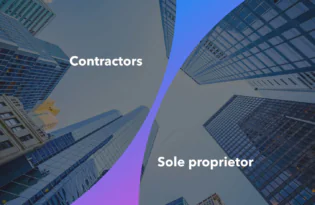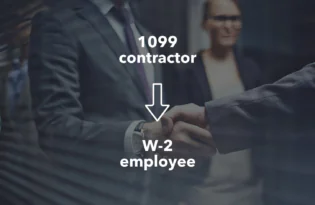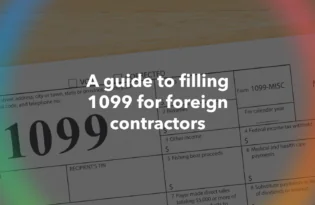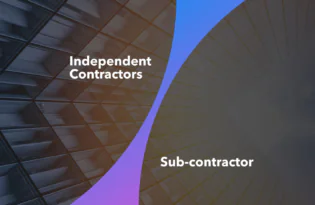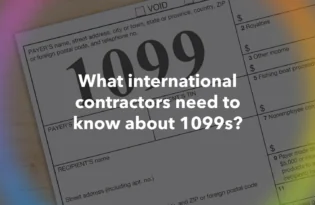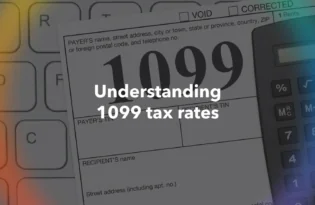How to pay independent contractors
Wondering how to pay independent contractors? Our step-by-step guide breaks down what to consider so you can pay them correctly and stay compliant.

The need for independent contractors and the popularity of remote work have increased recently. The ability to tap into the global labor pool has become a massive boon as companies broaden their worldwide reach.
That said, successfully utilizing this workforce requires understanding how to pay independent contractors. Errors in currency exchange rates, payment methods, or compliance might result in needless expenses and damaged relationships.
To help businesses navigate this process, we have created a practical, easy-to-follow guide that explains how to pay international contractors.
How to pay independent contractors: A simple guide
Here is a step-by-step guide on how to pay independent contractors. When hiring across borders, it’s critical to follow the right processes to stay compliant and efficient.
Step 1: Make sure the role qualifies as an independent contractor
Before onboarding or paying a contractor, you need to ensure they’re legally classified as such and not employees. Misclassification can trigger penalties, tax issues, and regulatory consequences, especially when hiring across borders.
| With Payoneer Workforce Management: Our trusted global partner network includes Agent of Record (AOR) services that make it easier to classify and hire international talent, all while staying compliant. |
Step 2: Establish payment terms and budget
You need to be able to identify if you are paying hourly, per project, or by milestones. Defining how and when a contractor is paid ensures alignment from day one and prevents disputes.
Be clear about your budget and how changes in scope will be handled. This will help avoid miscommunication later and give your contractor clear expectations.
| With Payoneer Workforce Management: You can pay contractors in 70 currencies worldwide. With flexible options, be they one-time, milestone-based, or recurring, our multi-currency wallet simplifies payouts across hundreds of markets. |
Step 3: Collect legal and tax documentation
For compliance, you need to ensure that you collect key documents from your contractor, such as:
- W-8BEN or W-9 form (depending on their location)
- Valid government-issued ID or passport
- Business registration (if applicable)
- Any certifications or licensing required for the role
These documents help verify legitimacy and support tax reporting obligations.
| With Payoneer Workforce Management: You gain access to onboarding tools that help collect contractor paperwork in one place–no spreadsheets. |
Step 4: Draft and sign a contractor agreement
Contract agreements should clearly outline project terms, IP ownership, deliverables, payment schedule, and local labor and tax laws/codes compliance. A strong independent contractor agreement typically outlines:
- Project scope and deliverables
- Timeline and milestones
- Payment structure and currency
- Tax responsibility (clearly defined)
- Intellectual property ownership
- Confidentiality/NDA terms
- Dispute resolution and exit terms
- Any clauses required by local law
| With Payoneer Workforce Management: Our global partner network offers legal expertise and an AOR service that helps you create localized contractor agreements. |
Step 5: Set up payment infrastructure
You’ll need to establish how payments will be sent.
- Bank wire transfers (reliable but expensive)
- Digital wallets like Payoneer (global support, currency flexibility, lower fees)
- Direct deposits (limited for international contractors)
- Mass payout systems for scale
Think about this: Do you send international wire transfers by hand? Be ready for hassles with foreign currencies, expensive fees, and delays. Independent contractors should typically be paid quickly, securely, and affordably.
| With Payoneer Workforce Management: Pay talent in over 160 countries with transparent fees. Your contractors can easily withdraw from their local bank or a digital wallet—whichever they prefer. |
Step 6: Navigate currency and compliance for international hires
When hiring globally, a few additional pieces come into play that you don’t need to worry about when hiring domestically.
| Currency Conversion | Contractors overwhelmingly prefer to be paid in their local currency. Using a multi-currency platform helps reduce foreign exchange fees and ensures smoother transactions. |
| Local Entity Requirements | Depending on the country, you may need to register a local entity (i.e., a legal business presence) before legally hiring or paying international contractors there. This adds time, legal complexity, and further administrative burden. |
Hiring overseas often means dealing with complex local labor laws, tax treaties, and compliance hurdles.
| With Payoneer Workforce Management: Whether working with direct contractors or leveraging our AOR service, Payoneer Workforce Management can help you engage with talent compliantly. |
Step 7: Use a contractor management platform
Managing this internally can be extremely time-consuming and error-prone, especially if you’re simultaneously hiring across multiple countries.
Contractor management platforms like Payoneer Workforce Management streamline the entire process, reducing the hassle and guesswork associated with paying independent contractors while staying compliant.
What you get when you pay independent contractors with Payoneer Workforce Management
| Seamless contractor paperwork collection | Handle multi-currency payments globally |
| Mitigate misclassification risks | Payment tracking and reporting tools |
Ready to simplify how you pay independent contractors?
You’re not alone if you’re still unsure how to pay independent contractors, especially across borders. The process can be complex, confusing, and time-consuming, often hindering your business’s global expansion.
That’s where a contractor management platform like Payoneer Workforce Management comes in. With flexible global payment options and support for engaging overseas contractors through AOR partners, Payoneer Workforce Management lowers the barriers to international contracting. You get peace of mind and streamlined operations, so you can focus on what matters: growing your business.
Start engaging and paying independent contractors with confidence.
FAQs
1. How are independent contractors typically paid?
Independent contractors are usually paid per project, hourly, or on a milestone basis. Payments are made after invoices are submitted and approved. Common payment methods include bank transfers, digital payment platforms, and contractor management platforms.
2. Do I need to issue a 1099 to an independent contractor?
Yes, if you pay a U.S.-based contractor $600 or more in a calendar year, you must issue them a Form 1099-NEC. This does not apply to most foreign contractors, but you should still collect appropriate documentation like Form W-8BEN.
3. How do I structure a contractor payment?
To structure a contractor payment, start with a clear agreement that outlines the payment terms. Decide whether you’ll pay hourly, per project, or by milestone. Include payment amounts, due dates, invoicing procedures, and accepted payment methods. Make sure both parties agree in writing before work begins.
Related resources
Latest articles
-
Planning to hire employees in Portugal? Here’s a quick guide
Looking to hire employees in Portugal for your U.S. company? Learn about employment in Portugal and how Payoneer Workforce Management helps you hire in Portugal.
-
Planning to hire employees in Italy? Here’s a quick guide
Want to hire employees in Italy? Discover the most common hiring methods, legal requirements, and employer responsibilities of U.S. companies hiring in Italy.
-
Planning to hire employees in China? Here’s a quick guide
Are you looking to hire employees in China? Learn about employment in China and how Payoneer WFM can help American companies hiring in China.
-
Planning to hire employees in Mexico? Here’s a quick guide
Are you looking to hire employees in Mexico? Learn how to hire a team in Mexico and how Payoneer Workforce Management can help U.S. companies hiring in Mexico.
-
Planning to hire employees in Malaysia? Here’s a quick guide
Are you looking to hire employees in Malaysia? Learn about hiring in Malaysia and how Payoneer Workforce Management can help American companies hiring in Malaysia.
-
Optimizing your financial website for AI-powered search algorithms
SWIFT connects 11,000+ banks worldwide, powering secure international transfers. This guide explains how SWIFT works, why it’s still widely used, how to find your SWIFT code, and how Payoneer helps you receive global payments efficiently.
Disclaimer
The information in this article/on this page is intended for marketing and informational purposes only and does not constitute legal, financial, tax, or professional advice in any context. Payoneer and Payoneer Workforce Management are not liable for the accuracy, completeness or reliability of the information provided herein. Any opinions expressed are those of the individual author and may not reflect the views of Payoneer or Payoneer Workforce Management. All representations and warranties regarding the information presented are disclaimed. The information in this article/on this page reflects the details available at the time of publication. For the most up-to-date information, please consult a Payoneer and/or Payoneer Workforce Management representative or account executive.
Availability of cards and other products is subject to customer’s eligibility. Not all products are available in all jurisdictions in the same manner. Nothing herein should be understood as solicitation outside the jurisdiction where Payoneer Inc. or its affiliates is licensed to engage in payment services, unless permitted by applicable laws. Depending on or your eligibility, you may be offered the Corporate Purchasing Mastercard, issued by First Century Bank, N.A., under a license by Mastercard® and provided to you by Payoneer Inc., or the Payoneer Business Premium Debit Mastercard®, issued and provided from Ireland by Payoneer Europe Limited under a license by Mastercard®.
Skuad Pte Limited (a Payoneer group company) and its affiliates & subsidiaries provide EoR, AoR, and contractor management services.

